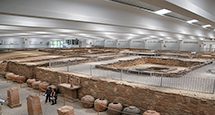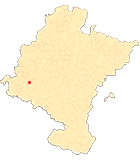The Roman villa of Arellano
Overview
The second construction phase began at the beginning of the 4th century A.D., the fields were cultivated again and, on the ruins of the old buildings destroyed by fire, a new, larger and more luxurious mansion was built. In the late imperial period the villae underwent a B development , a consequence of a progressive migration of the owners, who abandoned their homes in the city and moved to their rural possessions, turning them into permanent residences. This period saw a succession of extensions and ostentatious renovations, covering the rooms with elegant stucco painted on the walls and, above all, paving the floors with magnificent mosaics. This was the case of Arellano, with the singularity that its character of agricultural exploitation passed to a second plane, acquiring greater importance as a religious center, dedicated to the cult of Cibeles-Attis.
The final crisis of the empire must have marked the decline of the villa. However, before its definitive withdrawal , the site was occupied for the last time during the 6th century A.D. Reusing some of the rooms that were still standing, a small community dedicated to an industrial subject activity, related to iron metallurgy, settled there.
How to get there: The easiest way to get there is from the Pamplona - Logroño motorway, a few kilometres past Estella in the direction of Logroño, take exit 51 to Arróniz, on the NA-6340. After a few kilometres, the museum complex appears on the right.
Important: All information.
scheduleSee web page.
Bibliography: María Ángeles Mezquíriz Irujo, La villa romana de Arellano, Gobierno de Navarra, Pamplona, 2003.












